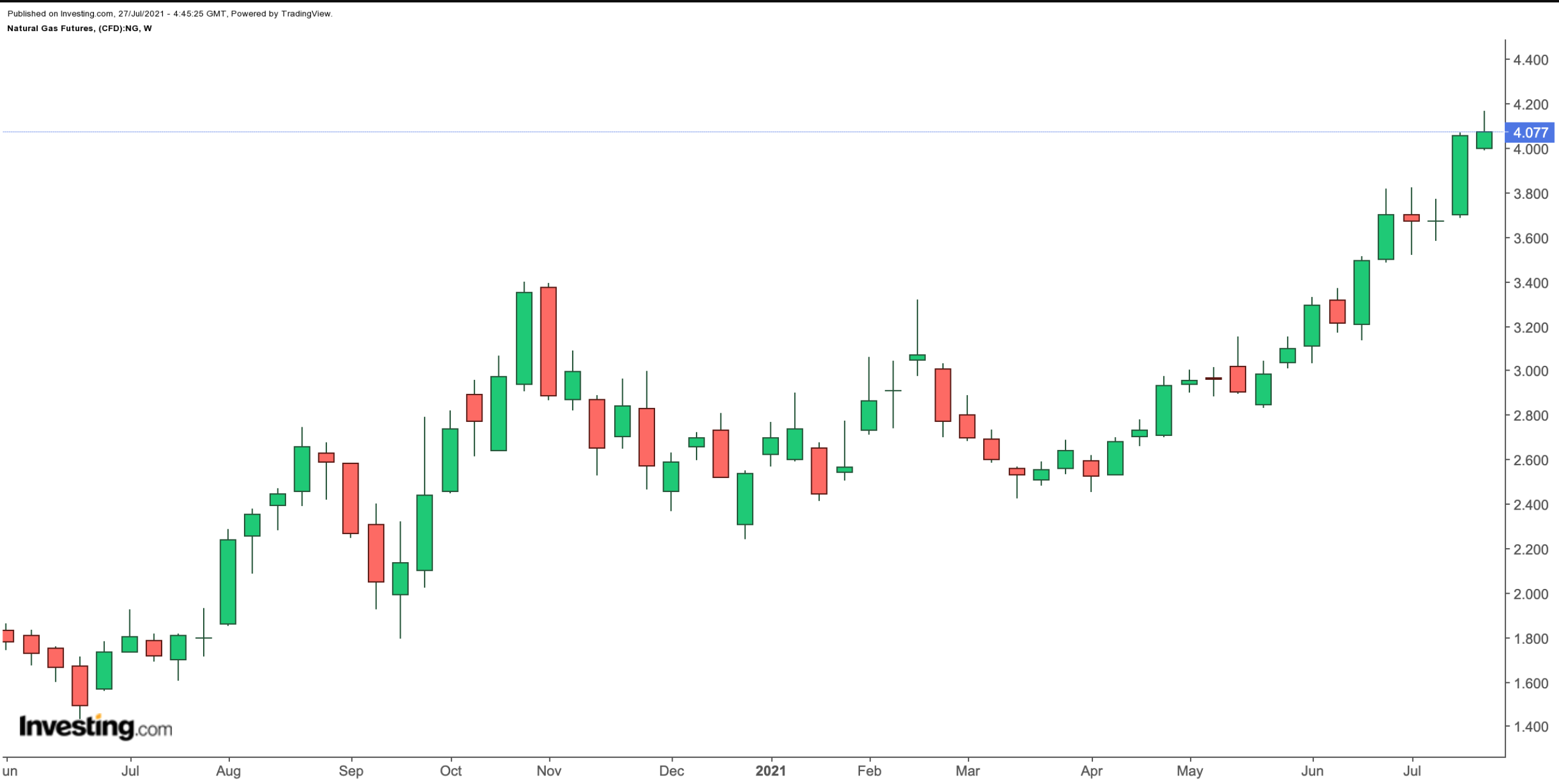Prices of most commodities have been falling in recent weeks, giving up months of gains. These declines have been widespread, extending to corn, copper, lumber, palladium and platinum futures. But natural gas, a fossil fuel, has stood firm, and the price is above $4 per mmBtu, which stands for million metric British thermal units. Year-to-date, it returned more than 52%, and 61% in the past year.

Therefore, today we take a look at this critical commodity and discuss an exchange-traded product (ETP) that could be of interest to natural gas bulls.
The US Is The Leading Producer
In 2011, the US surpassed Russia to become the world's top producer of natural gas. Iran, Canada, Qatar, China and Norway are other leading producers. On the increasing demand side of the equation, we mainly have the US, China and the Middle East.
Over a third of total energy consumption in the US comes from natural gas. For instance, it accounts for about 40% of electricity generation. In addition, high summer temperatures mean a large number of people are turning on air conditioners, leading to greater demand for natural gas.
Moreover, about half of the residential homes in the country rely on natural gas for space and water heating as well as cooking. And various industries rely on natural gas for the production of chemicals, fertilizers and hydrogen. Five of the US states—namely Texas, California, Louisiana, Pennsylvania and Florida—account for more than a third of natural gas demand in the country.
Finally, the US pipeline and liquefied natural gas exports have increased significantly over the last several years. For example, US exports of LNG went up by 41% year-over-year.
Those investors who want to buy natural gas stocks follow a range of energy companies, including:
- Antero Resources (NYSE:AR) — up 151% YTD;
- Cabot Oil & Gas Corporation (NYSE:COG) — down 3% YTD;
- Cheniere Energy (NYSE:LNG) — up 39% YTD;
- EQT (NYSE:EQT) — up 59% YTD;
- Kinder Morgan (NYSE:KMI) — up 27% YTD;
- Royal Dutch Shell (NYSE:RDSa) (NYSE:RDSb) — up 8% YTD;
- Southwestern Energy (NYSE:SWN) — up 63% YTD.
Put another way, the returns in stocks have not always been similar to the return seen in the commodity. With that information, here's a fund that could appeal to those who want to invest in natural gas.
United States 12 Month Natural Gas Fund
Current Price: $10.97
52-week Range: $7.24 - $10.99
Expense Ratio: 0.90% per year
The United States 12 Month Natural Gas Fund (NYSE:UNL) is a commodity fund that started trading in November 2009. It is a small ETP with about $11 million under management.

UNL tracks the price of natural gas delivered at the Henry Hub, Louisiana. The fund holds 12 benchmark futures contracts extending out to the next 12 months. The daily price moves reflect the changes in these contracts.
This means that by holding and rolling exposure across 12 separate futures contracts, UNL gives 12 months of exposure to gas futures. This approach sets UNL apart from another natural gas fund, namely the United States Natural Gas Fund (NYSE:UNG).
Instead, UNG holds and rolls exposure in only the front futures contract, traded on the NYMEX. About two weeks before expiry, fund managers roll the exposure into the second-month contract.
We previously discussed the concept of rolling over, which can be costly, affecting returns of commodity funds. In fact, rolling over usually creates losses, as the roll yield tends to be negative. Therefore, funds like UNL and UNG are more appropriate as a short-term trading tool but not a long-term investment fund.
If we had to compare UNL with UNG, the sister fund, we see that over a 12-month period the returns are higher for UNL:
UNL: up 41.8% over the past year;
UNG: up 32.6% over the past year.
In the case of UNL, investors have less exposure (i.e., 1/12th) to the front contract because they hold further out along the futures curve. Therefore, they have less exposure to the roll yield.
Readers should remember that such commodity funds that utilize futures contracts are not suitable for long-term portfolios. But if we had to choose between UNL and UNG, we’d go with UNL.
Given how far natural gas prices are up in the past several months, interested investors might want to wait for a pullback of about 7%-10% before starting a new position.
Finally, market participants who do not want to commit capital into commodity funds, but instead want to include exchange-traded funds (ETFs) that hold natural gas stocks might want to research the following funds further:
First Trust Natural Gas ETF (NYSE:FCG) — up 59% YTD;
Invesco DWA Energy Momentum ETF (NASDAQ:PXI) — up 47% YTD;
SPDR® S&P Oil & Gas Exploration & Production ETF (NYSE:XOP) — up 44% YTD;
VanEck Vectors Unconventional Oil & Gas ETF (NYSE:FRAK) — up 51% YTD.
We will cover these ETFs in the coming weeks.
